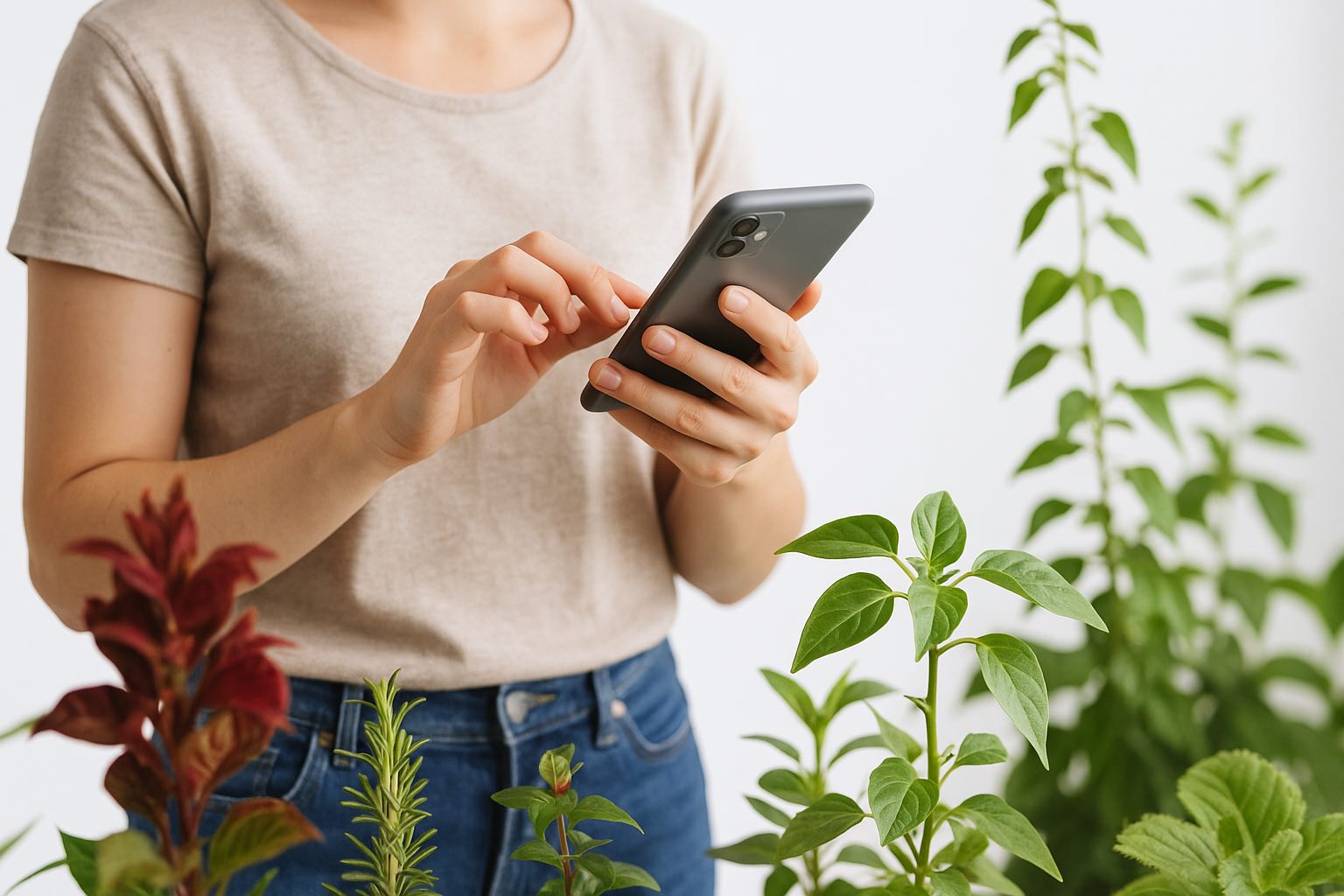There’s something deeply satisfying about watching a garden come to life—especially one you’ve carefully planned from the start. If you love digging into the details before digging into the soil, adding a little tech to your process can make things smoother and more rewarding. Garden planning apps bring your ideas to life before you plant a single seed, helping you feel more prepared and confident about what’s ahead.
This guide will walk you through the best gardening apps specifically designed to help you map out your perfect green space.
Why Use a Garden Planning App?
If you’re someone who enjoys sketching out ideas or flipping through seed catalogs on a winter afternoon, you already understand that a garden begins long before planting day. These apps help turn that early-season excitement into a plan you can stick with.
- Visualization: Many apps let you map out your space visually, so you can try different layouts, mix and match plant types, and imagine how it will all look once everything’s growing. It’s a simple way to play with ideas before making real changes in the soil.
- Make the Most of Your Space: Planning ahead helps you avoid overcrowding, plant in the right spots based on sunlight, and even space things out properly. Some apps can also help you track which crops go where over time—useful if you want to rotate plantings and keep your soil healthy.
- Stay Organized: Whether you’re planting a few herbs or mapping out a full vegetable plot, these tools help you keep track of what’s been planted, what’s coming next, and when to expect harvest. No more trying to remember which row had the carrots.
Our Review Process: How We Chose the Best Apps
Before we get into the list, we want you to know that we didn’t just pull these names out of a hat. Our team personally downloaded, tested, and spent time with a whole range of gardening apps. We got our hands dirty (digitally, of course 🙂 ) by using them for real-world scenarios—planning a new vegetable patch, redesigning a flower bed, and even trying to squeeze a herb garden onto a tiny balcony layout.
Our goal was to see which apps truly deliver on their promises. We looked at a few key things for each one:
- Ease of Use: Was it intuitive right from the start, or did we need a manual just to find the settings?
- Practical Planning Power: How well did it actually help us plan? We looked for useful features like smart spacing suggestions, companion planting guides, and customizable calendars.
- Real-World Value: Is the free version genuinely useful, or are all the best features locked behind a hefty paywall? We wanted to find apps that respect your time and your budget.
You can think of this list below as a trusted recommendation. We did the homework so you can spend less time searching and more time planning the garden you’ve been dreaming of.
Best Gardening Apps for Visualizing Your Garden Layout
For those who are all about the aesthetics and layout, these apps excel at the design aspect of garden planning. They often feature drag-and-drop interfaces and options to add structures like paths or furniture.
Gardena myGarden
This free web app helps you design your garden with a charming, hand-drawn sketch aesthetic. It’s incredibly intuitive, making it easy to create a beautiful and functional plan from scratch.
- Best For: New homeowners or anyone planning a garden from the ground up, especially if you also need to map out an irrigation system.
- Key Strengths: The drag-and-drop interface is a breeze to use. Its built-in sprinkler system planner is a standout feature that you won’t find in most other apps. It’s completely free to use.
- Potential Drawbacks: As a web-based tool, it doesn’t have a dedicated mobile app for making tweaks while you’re out in the yard. The plant library is more geared toward landscaping than detailed vegetable gardening.
- Platform: Web-based
- Cost: Free
SmartDraw
SmartDraw is a powerful, multi-purpose diagramming tool that comes loaded with templates for creating precise, professional-looking 2D garden layouts.
- Best For: The meticulous planner who wants to create an accurate, to-scale drawing of their property. It’s excellent for large or complex garden designs.
- Key Strengths: It has a massive library of symbols and templates for plants, hardscaping, and more. The alignment and measurement tools are top-notch for creating precise layouts.
- Potential Drawbacks: It’s a general diagramming tool, not a dedicated gardening app, so it lacks plant-specific advice like companion planting or spacing needs. The interface can feel a bit corporate.
- Platform: Web-based
- Cost: Paid with a free trial
iScape
This app is a visual powerhouse, allowing you to design in 2D and 3D. Its standout feature is augmented reality, which lets you see your virtual design overlaid on your actual garden.
- Best For: The visual gardener who needs to see their plan in action before buying plants. It’s perfect for landscape design and planning flower beds.
- Key Strengths: The augmented reality (AR) feature is a game-changer and works surprisingly well for visualizing your plans. The library of plants and design elements is extensive.
- Potential Drawbacks: The core design features that make it so powerful are part of the paid subscription. It can be a bit complex to learn at first.
- Platform: iOS
- Cost: Freemium
Best Apps for Detailed Plant and Vegetable Garden Planning
Once you have a layout in mind, these apps help with the nitty-gritty details of planting and growing, especially for vegetable gardens. They often include features like planting calendars based on your local climate and companion planting guides.
Garden Plan Pro
This is a robust planning tool created specifically for vegetable gardeners who want to maximize their harvest and manage their garden intelligently.
- Best For: Serious vegetable gardeners focused on high yields, crop rotation, and getting their timing just right.
- Key Strengths: It uses climate data from thousands of weather stations for highly accurate planting and harvesting dates. The crop rotation advice is fantastic for maintaining soil health season after season.
- Potential Drawbacks: It’s a paid app with no free version. The interface is highly functional but not as visually polished as some others.
- Platform: iOS
- Cost: Paid
Planter
Praised for its simplicity, Planter uses a straightforward grid system that is perfect for planning raised beds and small-space gardens.
- Best For: Beginners, as well as gardeners who use the square-foot gardening method.
- Key Strengths: Its simplicity is its greatest asset. The visual grid makes it incredibly easy to understand proper plant spacing, and it offers great at-a-glance information on which plants are friends and which are foes.
- Potential Drawbacks: It might be too basic for gardeners with large or irregularly shaped plots. The free version limits the number of plants you can add to your plan.
- Platform: iOS, Android, Web-based
- Cost: Freemium
GrowVeg Garden Planner
A comprehensive and flexible planning tool, this app adapts to your garden size and style, providing support from the first seed to the final harvest.
- Best For: The dedicated food gardener who wants an all-in-one planning partner that helps manage the garden over multiple seasons.
- Key Strengths: It’s incredibly adaptable, working for everything from traditional rows to intensive raised beds. The personalized planting calendar and twice-monthly email reminders are extremely helpful.
- Potential Drawbacks: It is a subscription-based service and can feel a bit overwhelming for a brand new gardener due to its sheer number of features.
- Platform: Web-based
- Cost: Paid with a free trial
All-in-One Gardening Apps with Planning Features
Some apps do it all, combining planning tools with other useful features like plant identification and care reminders.
Gardenize
Think of this app as a living digital journal for your garden. It’s built to help you keep track of everything you do and how your plants are growing.
- Best For: The gardener who loves to document everything. It’s perfect for tracking plant progress, keeping notes, and setting care reminders.
- Key Strengths: It’s excellent for creating a visual history of your garden with your own photos and notes. The ability to set custom reminders for watering and feeding is incredibly useful.
- Potential Drawbacks: Its layout planning tools are not as robust as dedicated planners. It’s more about recording what you’ve already done than designing a new space from scratch.
- Platform: iOS, Android
- Cost: Freemium
Garden Tags
This app is essentially a social network for plant lovers, combining a vibrant community with plant care and journaling tools.
- Best For: The social gardener who loves getting inspiration and troubleshooting advice from a community of peers.
- Key Strengths: The community is an invaluable resource for identifying unknown plants and solving garden problems. It’s a great place to keep a photographic diary of your plants’ progress.
- Potential Drawbacks: The core focus is on community and journaling, so its garden planning features are less developed. The social feed can feel distracting if you just want to focus on your plan.
- Platform: iOS, Android
- Cost: Freemium
Moon & Garden
For those who garden by a different rhythm, this app schedules all your gardening tasks according to the phases of the moon and biodynamic principles.
- Best For: Gardeners who practice or are curious about biodynamic methods and planting by the moon.
- Key Strengths: It provides a simple, easy-to-follow calendar that tells you the optimal days for planting, pruning, and harvesting. It’s a unique approach that many gardeners swear by.
- Potential Drawbacks: Its methodology is niche and won’t appeal to every gardener. It acts more as a scheduling guide than a visual layout planner.
- Platform: iOS, Android
- Cost: Freemium
How to Choose the Right Gardening App for You
With so many options, the best app is the one that fits your specific needs. Here are a few things to consider:
- Your Gardening Style: Are you focused on a sprawling vegetable patch, a few raised beds, or a small container garden? Some apps are better suited for large layouts, while others excel at the details of small-scale gardening.
- Tech-Savviness: If you prefer a straightforward approach, look for an app with a simple, intuitive interface. If you enjoy more robust features, a more complex app might be a better fit.
- Budget: Many apps offer excellent free versions that are perfect for getting started. Paid apps often provide more advanced features like detailed local climate data or extensive plant libraries.
Bring Your Garden Ideas to Life
No matter which app you choose, using a digital tool can make the process of planning your garden more organized, efficient, and enjoyable. With the right technology in your pocket, you’re one step closer to creating the garden you’ve always imagined.
Have you used any of these apps, or do you have another favorite? Share your experiences in the comments below




